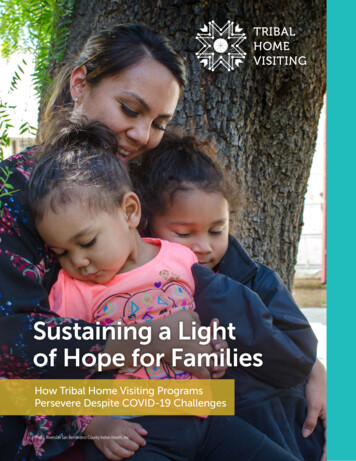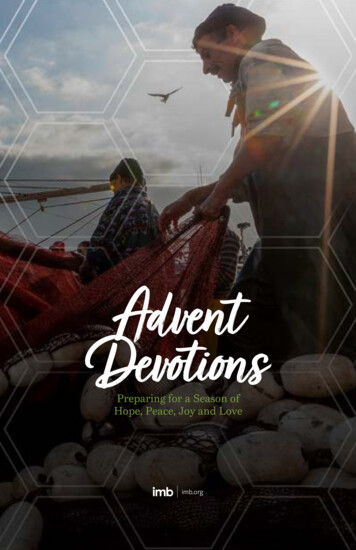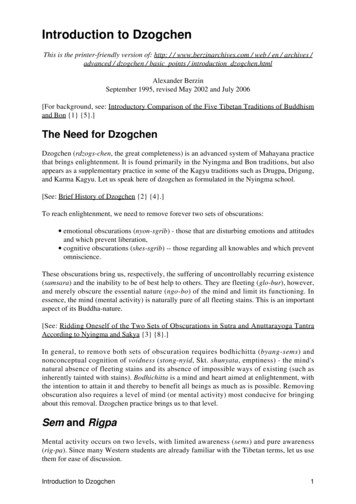
Transcription
Sustaining a Lightof Hope for FamiliesHow Tribal Home Visiting ProgramsPersevere Despite COVID-19 ChallengesPhoto: Riverside San Bernardino County Indian Health, Inc.
THE COVID-19 PANDEMIC IS CAUSING CHALLENGES FOR COMMUNITIES ACROSSthe world. In the United States, it is having an outsized impact on the AmericanIndian and Alaska Native (AIAN) community. For some, the pandemic may betriggering trauma that AIAN people have endured since colonization. For all, therapid spread of the virus, especially on reservations, is threatening the lives of toomany loved ones.Even during the darkest moments of the pandemic, home visiting programs havebeen able to sustain a light of hope for families. When other providers paused orended services, home visitors continued to show up for families. Some have commented that home visitors were “made” for times like this. They have been trainedto assess and respond to individual family situations, providing the care and supportthat helps families to be their best. Their nimbleness and sincere belief that all willbe well on the other side of a challenge sparked innovations that allow programsto continue to serve families during the pandemic. Home visiting has truly been anessential service and a lifeline for families. Home visitors are providing virtual visits,delivering books and essential supplies to families’ porches, helping families connect to resources in the community, and ofering virtual group sessions to connectfamilies safely with one another and reduce feelings of isolation. All the while, homevisiting program leadership is re-doubling their commitment to staf well-being andmaximizing connections with other service providers in the community.“The support home visitors provided served as a bufer for some families experiencing adiferent level of hardship.” APRIL WINTERS, HOME VISITOR, TAOS PUEBLOThis issue brief—based on interviews with three Tribal Maternal, Infant, and EarlyChildhood Home Visiting (Tribal MIECHV) grantees1—is about how Tribal MIECHVgrantees and their staf are approaching the COVID-19 pandemic with agility, adaptability, and innovation. With connection to their culture and values, Tribal MIECHVprogram leadership and staf are doing what is needed to care for their children,families, and one another. This brief details the experiences of three Tribal MIECHVgrantees during the pandemic, but their stories only hint at the commitment, creativity, and perseverance exhibited by the community of Tribal MIECHV grantees.1 Grantees interviewed for this brief include Cook Inlet Tribal Council, Inc., Riverside–San Bernardino County Indian Health, Inc., and Taos Pueblo.Sustaining a Light of Hope for Families2
The COVID-19 Pandemic:Unprecedented in Modern American HistoryThe impact of the COVID-19 pandemic is unprecedented in modern American history. What beganin early 2020 as a quick spike of cases in theNorthwest spread in short order to metropolitanareas and is now devastating rural communities. Unlike a typical natural disaster such as anearthquake or food, which often happens suddenly before focus turns to cleanup and recovery,COVID-19 is coming in waves, each one seemingmore harmful than the last. Across the country,hospitals and clinics have been overwhelmed;schools and child care centers have been shuttered; public gatherings have been limited; and lifeas usual has been disrupted.The Centers for Disease Control and Prevention(CDC) notes that the AIAN community has experienced disproportionate rates of infection andmortality during the COVID-19 pandemic. Infact, compared with the infection rates of Whitenon-Hispanic persons, AIAN infection rates are1.8 times higher, and mortality rates are 2.6 timeshigher.2 Since these data were collected, the spreadof COVID-19 has only worsened. Tribal communities implemented lockdowns, stay-at-homeorders, curfews, and reservation border closingsin an attempt to stop the spread of the virus. Still,the number of positive cases and deaths continuesto rise. Especially hard hit, as of December 2020,the Navajo Nation had uncontrolled spread in 77counties, and nearly 20,000 confrmed cases thatresulted in 727 deaths.3Not surprisingly, the pandemic is taking a heavy tollon Tribal MIECHV families in terms of not only theirphysical well-being but also their emotional andfnancial well-being, as well as their connections toneeded services. Emotional challenges: Home visitors reportthat families are experiencing increased stress,anxiety, and depression. Social isolation is aconcern, and many cultural and communitysupports that families normally turn to in timesof challenge are not available. Grantees havenoted a reduction in the success rate of breastfeeding, increases in intimate partner violence,and substance misuse relapse. For pregnantwomen nearing delivery, there is worry thathospital or clinic policies might not allow laborand delivery birthing support. Financial challenges: Grantees report signifcantly more underemployment and unemployment among families. Food insecurityis unprecedented. Some families are havingdifculty fnding housing because landlords arehesitant to sign new leases, so they are movingin with other family members. Many familieslack basic supplies such as diapers. Connections to needed services: Broadbandissues are a challenge for some families, making it either difcult or impossible to participate in virtual home visits or engage in onlinelearning. Many families don’t have access tochild care or Head Start; if they have access,they worry that it is not safe. Parents are overwhelmed with trying to guide children throughremote learning. Some are putting of visits toclinics for routine care such as well-child visits,immunizations, and dental checks.Families served by the home visiting program arenot the only ones struggling. Home visitors andprogram leaders themselves refect on the toll thepandemic is taking: “The kids and I tested positive. I was sick for just4 or 5 days, but the brain fogginess lingered. Ialso lost my grandpa to COVID. It took him in 24hours. It’s truly one heartache after another, andI am trying to continue moving forwardand doing the best I can for everyone.” APRIL WINTERS, HOME VISITOR, TAOS PUEBLO2 ccineConveningPolicyBriefFnl.pdf3 by-race-ethnicity.html#footnote03Sustaining a Light of Hope for Families3
“COVID is a marathon, and it is afecting allof us—staf and families. Fortunately, CITCrecognizes that we are not just staf, we arecommunity members and parents tryingto homeschool.” DEBORAH NORTHBURG,SENIOR DIRECTOR, CHILD AND FAMILY SERVICESDEPARTMENT, CITC “Our staf struggle with not being able to havehuman contact with the families they serve.They do not want to lose their relationship withtheir clients.” BILL THOMSEN, CHIEF OPERATIONSOFFICER, RIVERSIDE–SAN BERNARDINO COUNTYINDIAN HEALTH, INC.Photo: Choctaw Nation of OklahomaDespite the enormity of the challenges presented byCOVID-19, Tribal MIECHV programs are persevering. “The leadership saw our home visiting staf asessential workers—they knew we might be the frstcontact with a family that is experiencing anxietyor depression,” said Jaclyn Gray, Program Director,Riverside–San Bernardino County Indian Health, Inc.I have three children — 4, 10, and13. The pandemic has been hard for us. Idon’t like to be in public places, becauseI get anxiety. I would like to get a job, butI’m afraid to put the kids in day care. Whatif they get COVID? I thought about movingcloser to my family because my Dad hascancer and they didn’t have the virus, but Ican’t be too far from my son’s father, andnow the cases there are climbing wheremy parents live. My youngest misses Gail,our family mentor. He saw her a few weeksback and was so excited. He wants to goice fshing with her. I’m trying to not stayhome too much, because I get anxiety. SoI take my youngest on short walks. Thathelps. My daughter was sick as a babyand spent one whole week in the hospitalbecause of RSV [respiratory syncytial virus].I worry what will happen if she gets thevirus. I pray and ask God to protect us fromthe virus. I look forward to the day I can goout without a mask, and without anxiety. ANNUNCIATA SETON, PARENT, COOK INLET TRIBALLeadership knew that home visiting supports wereneeded now more than ever before. With that reality,program leadership embraced the pandemic as aperiod to be nimble and innovate, all in service of thefamilies and communities they cherish.Experiences from theFieldThis brief looks closely at three Tribal MIECHVgrantees to understand their experience withCOVID-19 and the unique aspects of their programs that contributed to their being able tosustain a light of hope for families. CITC beneftedfrom long-term leadership and a strong multiservice organizational structure, connection to aclear set of values, and the adoption of practicesto support staf well-being. Taos Pueblo beneftedfrom a small but mighty home visiting team thatvalued communication and co-creation no matter the challenge, a nimble approach to deliveringservices, adapting resources from others, and theirconnection to nature. The home visiting programat Riverside–San Bernardino County Indian HealthClinic, Inc., benefted from being connected toa large health care company, commitment tosupporting staf, and a strong sense of communityresponsibility.COUNCIL, INC. (CITC)Sustaining a Light of Hope for Families4
IMPLEMENTING AGENCYTaos Pueblo Division ofHealth and CommunityServicesRiverside–San BernardinoCounty Indian Health, Inc.Cook Inlet TribalCouncilNonproft triballycontrolled and managedhealth care organizationNative AmericanTribally DesignatedOrganizationRural reservation andurban non-reservationacross large areas in CAUrban, non-reservationarea in Anchorage, AK20112016Parents as TeachersParents as Teachers12560106ORGANIZATION TYPETribeLOCATION OF COMMUNITYRural reservation andnon-reservation in TaosCounty, NMFIRST FUNDED AS TRIBAL MIECHV2011MODEL IMPLEMENTEDParents as TeachersMAXIMUM CAPACITY (FAMILIES)35NUMBER OF STAFF4Sustaining a Light of Hope for Families5
Parental stress, anxiety and depression were through the roof withthree moms I serve.One was always tearful and struggling. Her kids weren’t listening to her, and they were climbing the walls. The older one was stirring up the younger ones. It felt to the mom that they wereganging up on her. At one point, she was talking about leaving the family and just disappearing.I was able to connect her to a mental health urgent care center. I called her every day until sheconnected with a therapist. She is now getting online counseling and support.Photo: United Indians of All Tribes FoundationAnother mom had moved just before the pandemic and didn’t have access to family andfriends. Her depression was getting worse, and I knew she needed help. It was hard to fndsomeone for her to talk with, because so many places were shut down. I just keep calling andpersisted. Now she is seeing a psychiatrist and getting weekly online counseling.Yet another mom had very high anxiety before the pandemic. When this happened, it took herover the top. She shut herself and her fve kids in a three-bedroom apartment and would not letthe kids out to play. The older one would stay home and watch the younger kids while the momwould go to the grocery store with her gloves. She would sit outside on the porch and wipeeverything down. She asked me often what I knew about COVID, and so I would go to the CDCwebsite and give her updated information. The mom started to calm, and then her sister camefor a visit and they all got COVID. The mom and her baby ended up in the hospital. Everyoneis better now, but her anxiety has returned. Now she is worried about her kids falling behind inschool. She keeps in contact with the teachers and advocates for the fact that she has four inschool plus a 2-year-old at home who is running around. She is doing all she can to keep everyone on task. MARILYN DELAOSSA, HOME VISITOR, RIVERSIDE–SAN BERNARDINO COUNTY INDIAN HEALTH, INC.Sustaining a Light of Hope for Families6
Cook Inlet Tribal Council, Inc. (CITC)Photo: Native Health, Inc.CITC has been a Tribal MIECHV grantee since 2016and provides the Parents as Teachers home visitingmodel to AIAN families with children from birthto kindergarten entry living in Anchorage, Alaska.Ch’anik’en (translated as “little one” or “child”) isnested within the CITC multiservice system and canserve up to 60 families.In mid-March 2020, in anticipation of the COVID19 pandemic, there was an emergency session ofthe Board of Directors to develop a solid emergency operations policy, including technology forstaf to telework and cell phone allowances. Forthe home visiting staf, it would be diferent fromtheir response to a 7.0-magnitude earthquake in2018. Then, staf ofces were relocated, but theywere still able to make home visits; with COVID19, in-person contact with families was contingenton the virus spread. During the summer monthswhen cases were low, family mentors could meetfamilies outdoors, but as cases multiplied in the fall,they had to switch to virtual visits. “We got quicklyto work to develop structure around what teleworkwould look like. We created tips and guidelines forstaf and managers, got Zoom subscriptions, andtrained staf on how to use it. Efective and regularcommunication was key—from the CEO, acrossdepartments, and within the home visiting program,” said Northburg.Three things stand out as important to CITC’s abilityto navigate the pandemic: (1) the long-term leadership, organizational structure, and multiserviceSustaining a Light of Hope for Familiesnature of the company; (2) the connection to aclear set of cultural values; and (3) a deep concernand real support for staf wellness.LONG-TERM LEADERSHIP, ASTRONG ORGANIZATIONALSTRUCTURE, AND MULTISERVICESUPPORTCITC benefts from having a visionary leader at thehelm. President and CEO Gloria O’Neill has been inthis role for more than 20 years. During her time,the organization has expanded to serve more than12,000 people each year across multiple programsthat aim to help individuals thrive. Service areasfocus on nurturing families, growing graduates,7
fnding jobs, and achieving sobriety. In 2006, all ofthe programs were co-located, which positionedstaf from across program areas to work closelytogether, including engaging in rapid problem solving. O’Neill sets a model for strong communicationand collaboration, which is practiced both withinthe organization and with external partners.During challenging times such as the currentCOVID-19 pandemic, CITC’s organizational structure supports the bidirectional sharing of experiences from leadership, staf, and participants. Thisinformation can then infuence the development ofpolicies and procedures that are most meaningfulto all involved. The structure includes: CITC Leadership Council. The LeadershipCouncil is made up of directors and seniordirectors of the various programs (e.g.,Child and Family Services, Clare Swan EarlyLearning Center, Youth EmpowermentServices, Employment and Training, AlaskaNative Justice Center, Recovery Services, andAlaska’s People), plus the directors of planning,accounting, fnance, communication, strategicprojects, and other support services. President’s Council. The President’s Councilis made up of the President and CEO; theExecutive Vice President and Chief FinancialOfcer and chiefs of operations, technology,legal, and administration. Board of Directors. The 17-person Board ofDirectors includes a representative from eachof the eight federally recognized tribes withinthe Cook-Inlet region, as well as nine representatives from Cook Inlet Region, Inc., aCITC – “Our Values”Our People have always understood that no one lives in isolation—individuals depend on eachother, as well as themselves. In a world that presents both challenges and opportunities, we mustwork together and be resilient. Each person has a responsibility to themselves, to their families, andto their community. We need to treat each other with respect. These cultural values are summarized in the organizational values of CITC, which guide us in everything we do:We are interdependent. We trust one another and work as a team toward our common goals. Werecognize that each of us has an equally important role in the community, and that we are strongertogether than as individuals.We are resilient. We look to the future with steadfast optimism, hope and faith in Our People. Weadapt to change with persistence and determination. We engage in creative solutions and endureadversity with courage.We are accountable. We are ultimately responsible for fulflling our mission and serving OurPeople. We are reliable, work with integrity and lead by example. We honor our obligations andcorrect our mistakes.We are respectful. We treat one another with dignity and kindness. We value and embrace ourdiversity, respect ourselves and understand boundaries. We approach each experience with gratitude and humility.We are humorous. Through humor, we laugh, connect, and build relationship; we use humor toshare joy and bring relief; humor is honest, liberating, and contagious, allowing us to be human andmeet each other where we are on our journey.Source: Accessed on 12/22/20 from https://citci.org/about/values/Sustaining a Light of Hope for Families8
land-based Alaska Native regional corporationwith more than 9,000 shareholders.According to Northburg, “The magic of this is thatyou have diferent perspectives from the broadersystems administration of the President’s Councilto the direct impact on staf and participants fromthe Leadership Council. This ensures we contemplate all of the aspects and consequences of policychanges together.”LEADING WITH VALUESTwenty-fve years ago, CITC adopted a set of valuesas part of a sustainability plan that was developedby participants, staf, and community thoughtleaders. The values provided a “North Star” for thework and were incorporated into many aspects ofthe program from service delivery to communication inside and outside the organization, to hiringand staf evaluations. Some suggest that the values, which are reviewed and updated periodically,contribute to their inner strength, their freedom todream big, and their ability to persevere in times ofchallenge.INVESTING IN STAFF WELL-BEINGWhen the earthquake struck in 2018, leaders tookaction to demonstrate that staf well-being wasa priority. This commitment to staf well-beingdeepened during the current pandemic. In additionto the cultural and organizational values describedearlier, a board-approved defnition of spiritualwellness further sets the tone for the care andattention directed to staf.Rallying after a Massive EarthquakeOn November 30, 2018, just before 8:30 a.m., a 7.0-magnitude earthquake struck north ofAnchorage. Some CITC staf were still arriving for work; others were getting ready to go out onassignment. “I was in the parking lot of the CITC building and getting ready to move a vehicle andthought something was wrong with the car,” said Nicole Hunter, Program Manager. The earthquakesignifcantly damaged the CITC building. A sprinkler system broke and fooded all four foors. Thebuilding sufered other structural damage, making it unsafe for occupancy.Gloria O’Neill, CITC President and CEO, was immediately responsive, reaching out to a partner agency—Southcentral Foundation—and requesting use of their space to bring all 200 CITC staf together fora meeting. “We had emotional support on-site and used talking circles to process with one another,develop coping skills, and provide emotional support,” said Northburg. Vasquez especially appreciatedthat there was a traditional healer present in addition to the behavioral health consultants.The CITC Leadership Council met to problem-solve staf and program participants’ issues and thenmade recommendations to the Board of Directors. The Board got right to work, issuing policies forstaf to work remotely. Sister agencies ofered up desk space for workstations. The TransportationCenter became a triage space for families receiving Tribal Temporary Assistance for Needy Families(TANF). The information technology department made sure that systems were up and running sofamilies would not have a disruption in benefts and staf could access participant data. They alsomade sure that home visiting staf had laptops and work cell phones so that they could be in touchwith their families and carry on with home visits. The Board approved self-care funds for staf.From the CITC leadership to the staf and clients served, all rallied and found ways to make the bestof the situation. Little did they know that their actions would serve as a dry run for the current COVID19 pandemic. Many of the past modifcations—such as provisions for remote work, technology forstaf, and stipends for self-care—are front and center in the organization’s current response.Sustaining a Light of Hope for Families9
“The CITC leadership as a unit is really genuine. They make all employees feel valued. They care aboutwhat is happening at home in our personal lives. The message is clear that we are in this together andit’s about one step at a time. That really helps with morale and wellness of everyone.” JESSTELLA VASQUEZ,FAMILY MENTOR“Spiritual Wellness is inner Balance, Belonging,Faith, Grace, Kindness, Love and Peace. It isnurtured through Relationships with self, others, and a power greater than ourself. SpiritualWellness is discovered through connections toeach other, traditions, land and our humanness:mind, body, and spirit.”4In a communication to CITC staf during the earlydays of the pandemic, O’Neill wrote about theimportance of wellness: “This is a gift we can giveourselves—the grace of spending time on our ownwellness. We cannot be present and supportive forothers without frst taking care of ourselves.” O’Neilland the Board implemented two policies that standout as exemplars.day to ground herself in the moment and letthe distractions from working at home quiet inher mind. Sometimes, she envisions a breathing bubble, breathing in for half a circle and outfor half a circle; other times, she focuses on thefve senses. She also uses this time to prioritizeher day so that she doesn’t feel overwhelmed.Family Mentor Gail Fitka worries that she is notable to protect and use the time as intended.She fnds it most helpful if she can take 30minutes in the middle of the day, but with additional families added to her caseload, she oftencannot carve out time until the end of the day,Photo: Pueblo San Felipe Stipends for Wellness. Staf were ofered aone-time 50 wellness stipend at the beginning of the pandemic. Some used the stipendto subscribe to apps such as Calm or RelaxMelodies; others purchased audiobooks andjournals; still others used it for online exerciseclasses. More recently, recognizing staf wellness as an ongoing priority, CITC implementeda 25 monthly stipend for all staf. Time for Personal Wellness and Self-Care.Staf are allowed 30 minutes per day duringwork hours for personal wellness or self-careactivities. Activities might include taking awalk, meditating, listening to music, journaling, breathing exercises, or other activitiesthat allow staf to center themselves. Homevisiting staf are also encouraged to participatein Mindfulness Mondays, virtual mindfulnesssessions organized by the Administrationfor Children and Families (ACF) Tribal HomeVisiting Program for Tribal MIECHV grantees.Family Mentor Jesstella Vasquez chooses touse her 30 minutes at the beginning of each4 E-mail communication from Gloria O’Neill to all CITC staf on April 9, 2020.Sustaining a Light of Hope for Families10
In addition to the wellness stipend and personaltime, a licensed professional conducts grouptalking circles for staf. One-on-one sessionsare available too, if staf need additional support.Recognizing that many of the staf have childrenat home, CITC has designated a space where thechildren of staf can gather to work on their schoolassignments and receive extra help when a parentneeds to work at the CITC ofce.Photo: Southcentral Foundationif at all. Although she may not be taking fulladvantage of this opportunity for herself, sheis very committed to reminding her familiesto take time for themselves and connect withnature. Fitka believes in the importance of connection to Native culture and nature and regularlyencourages her families to be outdoors with theirchildren, whether for a walk, to look for changesin nature, or to engage in traditional activitiessuch as ice fshing.Sustaining a Light of Hope for Families11
Taos PuebloTaos Pueblo has been a Tribal MIECHV granteesince 2011 and delivers the Parents as Teachersmodel to AIAN and non-Native families withchildren prenatal to kindergarten entry living ina remote, rural reservation and non-reservationarea in Taos County, New Mexico. The Tiwa BabiesHome Visiting program is part of the Taos PuebloDivision of Health and Community Services andcan serve up to 35 families.Photo: Taos PuebloStaf of the home visiting program started preparing in early March for the COVID-19 pandemic.They expected that the virus would come to TaosPueblo, but they did not know when. Because ofTribal self-governance5 and being a small, tightknit community, they were able to move forwardquickly and with confdence. Also, staf refectsthat Tribal sovereignty (or self-control) creates anenvironment of mutual respect, determinationto fnd solutions, and a commitment to community survival. In short order, they worked with theinformation technology staf to procure laptopsand confrmed that all staf had cell phones to usewhen contacting families. By the second weekof March, it became clear that they needed tostart making adjustments to their programming.In-person visits were no longer possible, and eventshad to be canceled. When the Tribe decided tosend workers home and then to close the Pueblo,all felt safe and prepared.Four things stand out as important to Taos Pueblo’sability to navigate the pandemic: (1) a small butmighty team that has weathered previous challenges and is committed to co-creating solutions,(2) a nimble approach to working with families, (3)leaning into supports and resources from others,and (4) connection to their vast lands and nature.“There is this intrinsic strength, fortitude, perseverance .a calmness and belief that we’re gonna getthrough this.” EZRA BAYLES, DIRECTOR OF HEALTH AND COMMUNITY SERVICES, TAOS PUEBLO5 Tribal self-governance refers to the ability of a Tribal community to be governed by its own members or citizens rather than having to conform to laws, practices,or procedures imposed by the state or federal government.Sustaining a Light of Hope for Families12
A SMALL BUT MIGHTY TEAMCOMMITTED TO CO-CREATINGSOLUTIONSThe home visiting program benefts from a teamthat is close knit, has experience weathering pastchallenges, enjoys strong communication, and iscommitted to co-creating solutions. The four-personteam enjoys a “can-do” spirit that team memberssuggest comes from the leadership style of TiwaBabies Home Visiting Program Coordinator KatherineChavez. “Katherine’s leadership helps us to navigatethese uncertain waters. It feels like a real partnership.Her support allows us to make the best informeddecisions for families,” said home visitor April Winters.Chavez emphasizes the importance of regular communication with her team for advancing the programand taking care of one another, and that has onlygrown during the pandemic. When staf needed towork remotely, Chavez checked in with each personevery morning to try to normalize the situation andkeep the focus on what the families need and howthe home visitors could best support them from adistance. In addition to the morning calls, the entireteam met for an hour and a half each week, providingspace for the staf to refect on their own COVID-19responses. The program coordinator also providedbiweekly refective supervision to encourage resilience and strength.In addition to strong communication, the team isexperienced with co-creating solutions. “Chavez setsthe tone for this,” according to Debra Heath, ProgramEvaluator. “She has a steady hand and positive outlook, sending the message to staf that we can fgureanything out if we work on it together. We may nothave all of the answers, but if we remain open andcurious, we will uncover the best next steps,” saidHeath. Chavez is comfortable with trial and error andthe patience that requires. “I guess one thing aboutour team we do a lot of planning together and haveopen and regular communication,” refected Chavez.Indeed, their communication and planning helpedthem during the COVID-19 pandemic to create asuite of supportive documents. The suite includesdocuments that ofer guidance on working fromhome, confdentiality strategies for protecting personal information, an outline of the diferent phasesof lockdown and what home visiting would look likefor each phase, and a checklist for how to conduct asafe, socially distanced visit. (Please see links to thesedocuments in the Appendix.)NIMBLE APPROACH TO WORKINGWITH FAMILIES“The curse of COVID-19 is the inability to meet inperson with the families. We are a small tribe andvalue personal contact. How do we re-create that“Serving the families is our North Star. The staf is passionate about this. It’s not just a job, it’s theirpurpose.” KATHERINE CHAVEZ, TIWA BABIES HOME VISITING PROGRAM COORDINATORPreparing for and Working Through ChallengesTaos Pueblo worked through some challenges before the COVID-19 pandemic that helped toprepare them for the pandemic.A large forest fre in 2003 on tribal lands helped to reinforce the need for emergency management that could be internal to the Pueblo. This well-trained frefghting team now
ing. “The leadership saw our home visiting staf as essential workers—they knew we might be the frst contact with a family that is experiencing anxiety or depression,” said Jaclyn Gray, Program Director, Riverside–San Bernardino County Indian Health, Inc. Leadership knew that home











